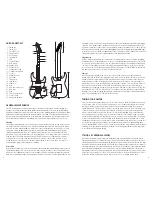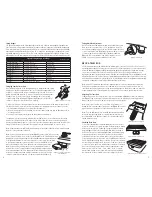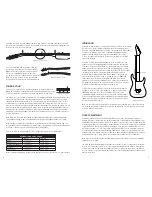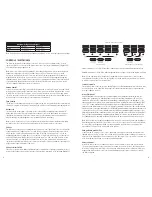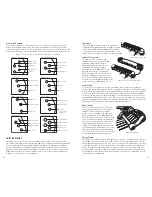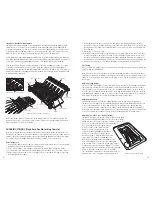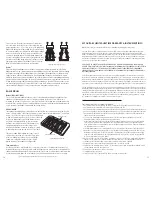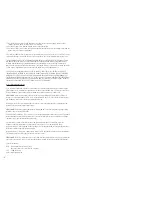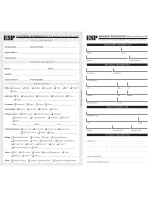
8
9
Series:
combination of coils in full output (this is traditionally how most humbucking pickups are wired).
Parallel:
combination of coils wired to reduce output and simulate a single coil, yet still remain hum-cancelling.
Note:
On some guitars with 2 pickups and no standard switch, a push-pull volume control is used to
select between the pickups (in this case, each pickup can only be turned on by itself-there is no position
in which both pickups are on at the same time).
Passive Electronics
Passive pickups and controls do not use a battery. They are considered standard electronics because there
is no manipulation of the signal from the pickup other than decreasing the volume or high frequencies
(nothing is added to the tone).
Active Electronics
Active pickups and circuits use power (9-volt alkaline battery) to manipulate the signal coming from the
pickups. Some systems may use a passive pickup in conjunction with an active preamp or EQ section. Any
combination will result in the output level of the guitar being considered Active or “Low Impedance”. If you
have active electronics or pickups in your guitar or bass, make sure your amplifier has an input labeled “LOW”
or “ACTIVE”. Using a standard input on an amplifier could result in unwanted distortion, as the signal will
overpower the amplifier’s input section. You should change your battery if your guitar or bass sounds distorted,
has a weak signal, or no output at all. Always use a high quality alkaline battery for maximum performance out
of your active electronics. To locate your battery, remove your battery compartment plate on the back of your
guitar using a regular Phillips screwdriver (In some cases, you may need to remove the electronics backplate If
you do not have a separate battery compartment).
Note:
Battery life for each active component ranges from
625-3000 playing hours. Generally, your battery life will be less with the more active components you have.
Note:
Active pickups do not require a bridge ground connection - a wire usually connecting the bridge or
part of bridge system to the back of the volume or tone controls. If you notice a loose wire not attached,
this most likely is the bridge ground and is normally installed in the guitar but not connected to the
ground (back of volume or tone control) with active pickups.
Push-pull/Push-push Coil Tap
Usually located on a volume or tone control - by pushing or pulling up on the knob, the switch will be
engaged. When in the “up” position, one coil from the pickup will be turned off making the output now
about half of the original signal. Since the pickup is now a true single coil, it is normal for it to have more
noise (hum) because the pickup is no longer a humbucking pickup.
Balance Control
Instead of a selector switch, it is traditional for basses to have a balance control with a center detent.
This controls which pickup’s output is being sent to the amp. In the center position, both pickups are at
full volume. Turning clockwise will select the neck pickup while turning counter-clockwise will select the
bridge pickup. With a balance control you can blend between pickups to get a certain tone or pickup
combination desired.
Maximum Bridge Pickup Heights
Bass Side
Treble Side
Guitars
2.5 mm (3/32”)
1.5 mm (1/16”)
Bass
3.5 mm (9/64”)
2.5 mm (3/32”)
Note:
Active pickups have less magnetic pull and may be adjusted closer to the strings than passive pickups.
CONTROLS / ELECTRONICS
The following are some brief descriptions of the basic electronic controls and terminology. For more
specific information on your exact model please refer to the control layouts and diagrams
(Figure 12)
or
visit our website at www.espguitars.com.
Note:
Most control knobs are easily tightened or removed by using a 2.0mm allen wrench or flathead
screwdriver to adjust the set screw on the side of the knob. If a knob becomes loose, you should
first remove the knob and check the control to make sure It Is properly tightened to the body before
re-tightening the knob onto the control shaft. A loose control shaft can easily be tightened using any
adjustable wrench. You will need to remove the electronics backplate and hold the control from the back
of the guitar while tightening the nut from the top of body. This will ensure that you do not move the
controls or damage / break any of the wire connections.
Volume Control
Controls the master output level of the guitar. Turning the knob clockwise will increase the volume while
turning counter-clockwise will decrease the volume. Some instruments will have multiple volume controls
in which case, you’ll find there’s a volume control for each pickup. Note: In the case of multiple volume
controls, when either volume control is turned off and the pickup selector switch is in the middle position
w/ both pickups on, the entire signal of the instrument will be turned off.
Tone Control
This adjusts the high frequencies present in the signal coming from your guitar. With the knob turned fully
clockwise, all frequencies are present. Turning the knob counter-clockwise decreases the high frequencies.
Output Jack
This is where the output signal of the guitar is sent to the amplifier by plugging in any standard 1⁄4”
guitar cable. Most output jacks are located near the bottom corner of the guitar below the electronics
cavity.
Note:
If your guitar or bass has active electronics, you should always remove your cable after
playing. Leaving your cable plugged into your instrument will drain the battery.
Note:
If your jack ever comes loose, do not tighten it without first removing the jackplate and securing
the inside of the jack, otherwise you may break the wires causing your guitar to lose output.
Pickups
The pickups on your guitar turn the string vibrations into an electronic signal that is sent to your amplifier.
Pickups are made up of magnets and coils of wire. There are 2 types of magnetic pickups used in most
electric guitars - Single Coils and Humbuckers. A Single Coil pickup is made up of only 1 coil of wire
and generally has a weak output. Due to its construction, a single coil will be noisy since it cannot block
hum and RF interference. Humbuckers on the other hand are in fact “hum-cancelling” because of their
construction using 2 coils side by side. The signals from each coil are combined in a certain way that
cancels the hum and RF interference that is common with single coil pickups. Humbuckers generally have
a higher output signal compared to single coils.
Pickup Selector Switch
The selector is used to switch between different pickups or combinations of pickups (on guitars with two or
more pickups). Pickup selector switches are either 3-way slotted, 3-way toggle, or 5-way slotted
(Figure 11)
.
5-way Ultraswitch
3-way Toggle & 3-way Slotted Switch
Figure 11:
Pickup Selector Switches
Содержание AC10E
Страница 1: ...O W N E R S M A N U A L W A R R A N T Y I N F O R M A T I O N V E R S I O N 1 3...
Страница 11: ......



